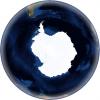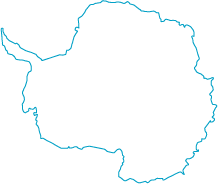Antarctica
Antarctica: Key Environmental Issues
Antarctica's two main environmental problems are pollution and global warming. The hole in the ozone above Antarctica is 27 million km2 which harms wildlife. Pollution consists of chemicals and garbage in the air and water. The snow in Antarctica contains chemicals used in other parts of the world and those chemicals are absorbed by the animals. Oil spills are another frequent problem with the marine traffic in the area.
Antarctica: Endangered Species
Antarctica has a wide range of species of concern. Species that are classified as either endangered or vulnerable are the whales however the species classified as of less concerned (not threatened) are seals, and birds. This classification is based on the IUCN 2006 Red List of Threatened Species.
Related Links
Antarctica: Parks and Protected Areas
There are currently no parks in Antarctica. The land management system is regulated by the International Association of Antarctic Tour Operators (IAATO) which applies strict guidelines for tour companies. Size restrictions are placed on boats and the number of people allowed on boats is limited. There are potential threats from bigger boats, growing numbers of people, and inadequate safety considerations.
Antarctica: Wildlife and Wildlife Management
Report prepared by Leanne Isaac and Dan Kriss, students in BCIT's Fish, Wildlife and Recreation Program.
In Antarctica there are a wide range of wildlife species that inhabits this bare (harsh) land and its surrounding waters and includes:
Antarctica: Fisheries and Fisheries Management
In Antarctica there are 203 species of bottom fish and seventy-three species of mesopelagic fish. Eighty-eight percent of these fish are endemic to Antarctica. Fisheries manage sealing, whaling, krill fishing, and bottom fish harvest. There has been no sealing since the 50s and no whaling since 1986 but there is concern for a number of bottom fish and the Antarctic Krill. Antarctic Krill numbers have been declining steadily due to overfishing.
Antarctica: Major Landscapes and Ecosystems
Antarctica is very mountainous and is largely covered by ice. It has almost 18,000 km of coastline and nearly half of the coast is covered in ice sheets from glaciers.
Antarctica: Introduction
 |
( categories: Antarctica )
|

 Funded by TEK
Funded by TEK